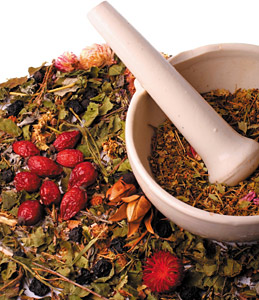Qing Bi Tang is one of the most commonly used herbal formulas for treating sinusitis, rhinitis and sinus infection. It clears nasal obstruction caused by damp heat: stuffy nose, yellow and sticky nasal discharge, sneezing, headache, itchy nose and throat, decreased sense of smell and energy level, and fatigue.
Composition
| ge gen (Radix puerariae lobatae) ma huang (Herba ephedrae) sheng jiang (Rhizoma zingiberis recens) yi yi ren (Semen coicis) jie geng (Radix platycodonis) xin yi hua (Flos magnoliae) shi gao (Gypsum fibrosum) da huang (Radix et rhizoma rhei) chuan xiong (Rhizoma chuanxiong) rou gui (Cortex cinnamomi) bai shao (Radix paeoniae alba) da zao (Fructus jujubae) gan cao (Radix et rhizoma glycyrrhizae) |
12 g 6 g 3 g 10 g 9 g 8 g 2 g 3 g 3 g 5 g 3 g 2 g 2 g |
Prepare ingredients as a warm decoction with meals to avoid possible digestive discomfort.
Qing Bi Tang specifically treats nasal obstruction caused by damp heat, with the diagnostic symptom of yellow and sticky discharge. This syndrome may occur secondary to an acute exterior attack or a chronic condition. If the nasal obstruction is the result of an exterior condition, other symptoms of an exterior attack may be present, such as sneezing, headache, aversion to cold- and itching of the nose and throat. If the nasal obstruction is chronic in nature, patients may experience a decreased sense of smell, decreased energy level, fatigue, and other allergy symptoms.
 Ge gen, ma huang and sheng jiang release exterior pathogens. Yi yi ren and jie geng drain dampness and eliminate pus. Xin yi hua opens the nasal passages and unblocks nasal obstruction. Shi gao and da huang, both cold in nature, clear heat and reduce swelling. Chuan xiong activates blood circulation and relieves headaches associated with nasal symptoms. Rou gui warms the body, dispels cold and moderates the harsh and cold properties of shi gao and da huang. Bai shao harmonizes ying (nutritive) and wei (defensive) levels, and balances the acrid and warm herbs in this formula. Da zao and gan cao harmonize the formula. If there is headache, add bai zhi (Radix angelicae dahuricae). For sinus infection, add huang qin (Radix scutellariae) and huang lian (Rhizoma coptidis).
Ge gen, ma huang and sheng jiang release exterior pathogens. Yi yi ren and jie geng drain dampness and eliminate pus. Xin yi hua opens the nasal passages and unblocks nasal obstruction. Shi gao and da huang, both cold in nature, clear heat and reduce swelling. Chuan xiong activates blood circulation and relieves headaches associated with nasal symptoms. Rou gui warms the body, dispels cold and moderates the harsh and cold properties of shi gao and da huang. Bai shao harmonizes ying (nutritive) and wei (defensive) levels, and balances the acrid and warm herbs in this formula. Da zao and gan cao harmonize the formula. If there is headache, add bai zhi (Radix angelicae dahuricae). For sinus infection, add huang qin (Radix scutellariae) and huang lian (Rhizoma coptidis).
Qing Bi Tang and You Bi Tang are formulated based on the clinical experience of past herbalists. These formulas have been refined after years of trial and error, and are very effective for treating sinusitis and rhinitis characterized by damp heat. The original sources of these two formulas are unavailable because they have not been formally cited in any reference or textbook.
There are three formulas that commonly treat various types of sinusitis and rhinitis. Cang Er Zi San (Xanthium Powder) is best for wind-heat condition characterized by nasal obstruction with yellow discharge. Xin Yi San (Magnolia Flower Powder) is most effective for wind-cold condition characterized by nasal obstruction with clear, white discharge. Qing Bi Tang targets damp-heat condition characterized by nasal obstruction with yellow, sticky nasal discharge that has a foul smell.
Click here for previous articles by John Chen, PhD, PharmD, OMD, LAc.




